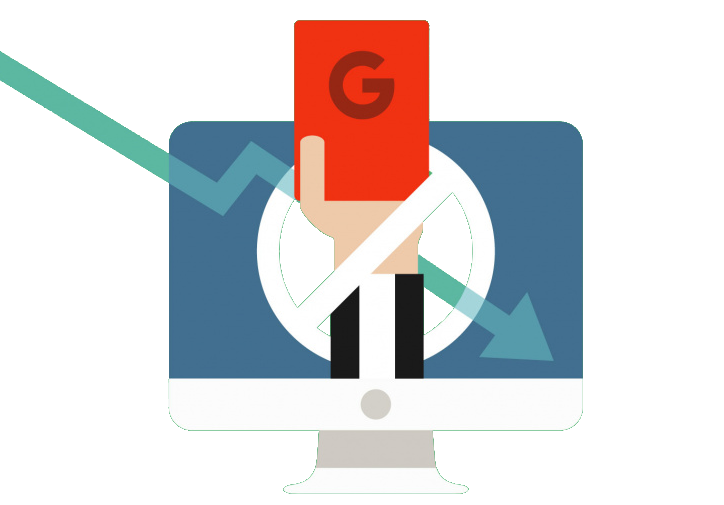Why search rankings matter
A whopping 75 percent of people don’t click past the first page of search results.

This means if your site doesn’t show up on the first page of Google search results, most people won’t find or contact your business. When your website doesn’t show up on Google, you miss out on qualified leads and revenue. So you’ll want to identify and fix the problem ASAP.
Reasons your site doesn’t rank — and how to fix poor rankings
A number of factors can influence your site’s Google rankings (or lack thereof).
Here are six reasons you might be wondering “why isn’t my website showing up on Google” and what you can do to fix it.
1. Your website isn’t indexed
Sites that aren’t indexed by Google won’t show up in search results — and there are several reasons your site isn’t being crawled and indexed by Google bots.
Your site is new
If your website is new, keep in mind that it can take several weeks for Google to index your site and reflect the changes in search results.
This is especially true for new websites since they don’t typically have many inbound links. Google considers both the number and quality of inbound links to sites when ranking them. It takes time to build up your domain authority, so don’t expect to see immediate rankings for a new website.
Your site has “no index” tags
If you have an older site that isn’t indexed, check your use of “no index” tags before searching “my website isn’t showing up on Google.”
Adding “no index” code to your site prevents search bots from crawling and indexing specific pages.
While there are some instances where you’d want to use “no index” tags, you’ll want to consult an SEO agency to make sure it’s done right and doesn’t prevent pages you want to rank from appearing in search results.
In addition, a robots.txt file can prevent Google crawlers from visiting entire portions of your site, so you’ll want to make sure you didn’t accidentally disallow pages you want to rank.
Websites that operate on WordPress have built-in features that instruct search engines not to index the sites. Owners need to disable the setting manually by visiting Settings >> Reading and unchecking the box next to Search Engine Visibility.
Wondering “how to index my site on Google”? Take a look at these tips
How to fix a non-indexed site
If your website isn’t indexed on Google, start by creating an account on Google Search Console.
This allows you to direct Google to your sitemap.xml and request it to crawl and index your URLs. It’s important to remember, though, that Google doesn’t guarantee site indexing, and if your site is new, it may still take time to rank in search engine results pages (SERPs). You can also update your site’s “no index” tags in your code and robots.txt to ensure Google bots can find, crawl, and index your pages.
2. Your website has a penalty

Penalties can also prevent your site from ranking in Google search results.
If your site doesn’t meet Google’s quality guidelines, it may temporarily or permanently remove your site from search results.
Google penalties include:
Check Google Search Console for penalty alerts. If your site gets penalized, you’ll need to take steps to modify your website to meet Google’s guidelines. Then, you can submit your site for reconsideration to get back on Google.
3. Your website isn’t optimized for search

If you’re searching “my website doesn’t show up on Google,” you might need to beef up your SEO.
Search engines like Google consider hundreds of factors when rankings sites — and SEO helps you ensure your website’s optimized to rank at the top of SERPs.
SEO spans several strategies designed to boost your rankings and help you earn more conversions (and revenue) online. You can have the most beautifully designed site, but without SEO, it won’t rank in SERPs. Not to mention, nobody will be able to find and contact your business.
How to fix a website that isn’t optimized for search
Start by conducting a comprehensive SEO audit of your site. An SEO audit allows you to identify areas for improvement and make the necessary fixes to achieve top rankings.
When optimizing your site for search, here are a few things you’ll want to consider:
1. Clean up your site’s code and technical SEO
2. Ensure your site loads quickly
3. Streamline your website design and navigation to provide a positive user experience
4. Include target keywords in your site copy, headings, and page titles
5. Create in-depth, quality content that answers searchers’ questions
Depending on your time and resources, you may decide to spring for a custom SEO package.
4. Your website’s content sucks

Speaking of content, if your site copy sucks, there’s a good chance your site won’t show up in Google search results.
Search engines like Google want to rank sites that provide quality content that matches a searcher’s intent and satisfies their queries.
When creating content, aim to make it comprehensive enough that it fully answers searchers’ questions, so they don’t have to hit the back button to check out other results.
While you don’t need to create full-length guides to rank in SERPs, it’s essential to provide searchers with valuable content that keeps them engaged on your site — and encourages them to contact you to take the next step.
How to fix content that sucks
If your content leaves something to be desired, consider partnering with a full-service content marketing agency like Tech Sailor to create custom site content. Our team understands how to create content that ranks in search results, and we’ll help you beef up existing pages to improve your position in the SERPs.
It’s also important to remember that search engines and users like fresh content, so keep yours updated regularly to achieve the best results.
5. Your keywords are too competitive
If you’re reading this post and thinking, “My content’s great and my website still isn’t showing up on Google,” then it’s time to revisit your keyword targeting.
Trying to rank for highly-competitive results, especially when competing with bigger brands, can sometimes leave your business in the dust. Instead, consider targeting long-tail, more specific phrases that contain three or more keywords.
While long-tail keywords have lower monthly search volumes, they are also less competitive, giving you a better chance of ranking at the top of search results. In addition, long-tail keywords typically have a more specific search intent.
For example, if someone searches a generic keyword like, “tent,” it’s hard to determine exactly what they want to find.
Do they want to know how to set up a tent? Are they researching the best tent for their next camping trip? Do they want to buy a specific type of tent?
On the other hand, if someone searches the long-tail phrase, “buy two-person backpacking tent,” you know that they’re ready to purchase.

Companies that sell outdoor gear will have an easier time ranking for the long-tail phrase “buy two-person backpacking tent,” and they can create content that matches that specific intent.
How to fix an overly ambitious keyword strategy
Successful SEO campaigns always start with keyword research.
Using tools like Keyword Tool, Keywords, and Google’s Keyword Planner, try to identify long-tail keywords with less competition that offer the most value to your business. Targeting less competitive phrases will allow you to show up in Google results and reach more customers online.
6. Your site doesn’t provide a good user experience (UX)

Finally, if your website delivers a poor user experience (UX), you can kiss top rankings goodbye.
Search engines want to rank valuable content and websites that provide visitors with a great experience. If users don’t have a positive experience on your website, they’ll waste no time hitting the back button — a signal to Google that your site shouldn’t rank.
Improving UX on your site can reduce bounce rates, engage visitors, and help them learn more about your business, all while helping you rank higher in search results.
How to fix a poor UX on your website
A few quick fixes can take your UX and site rankings to new heights. To improve your site’s UX, you can:
1. Speed up your site’s load time with page speed optimization services
2. Streamline your site’s navigation to make it easy to find information
3. Include visual elements to break up content and engage visitors
For more info on improving your site’s UX, check out our user experience analysis services.
Take charge of your rankings with SEO services from Tech Sailor

Tech Sailor offers custom SEO services to help your business rank at the top of search results and earn more revenue online.
We’ll audit your SEO strategy to determine why your site isn’t showing up on Google and help you implement solutions that drive results — and prevent you from searching “my website isn’t showing up on Google.”
Want to learn more? Contact us online or give us a ring at 888-256-9448 for a free SEO quote!












